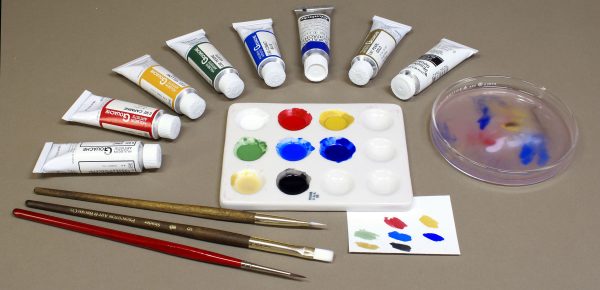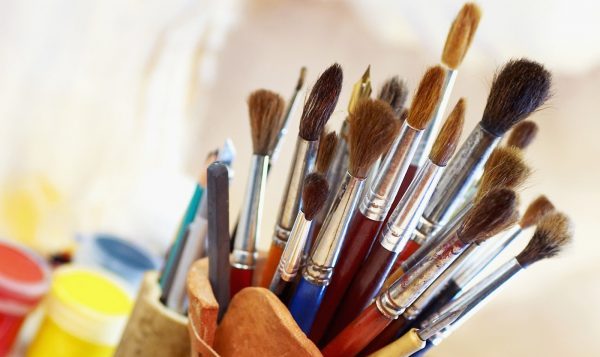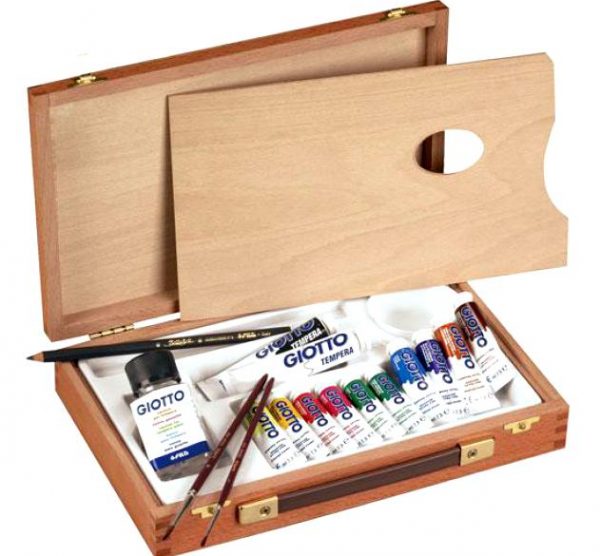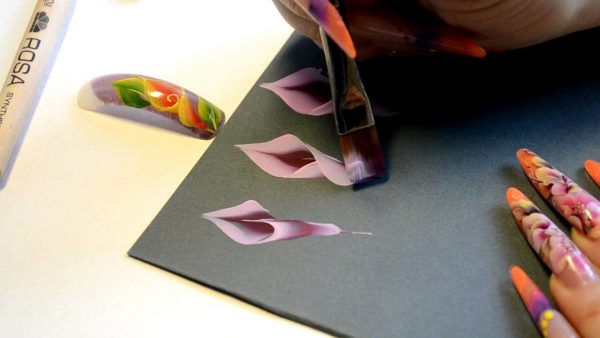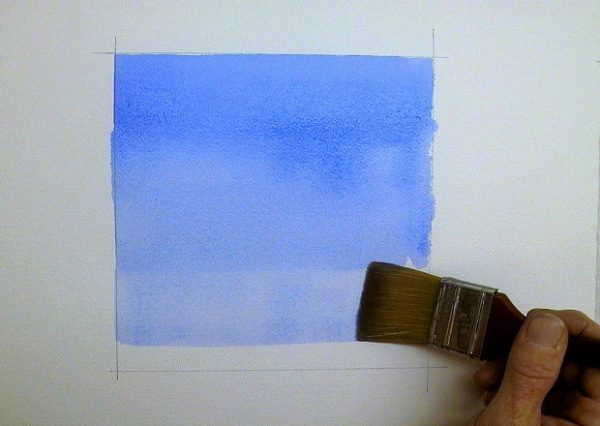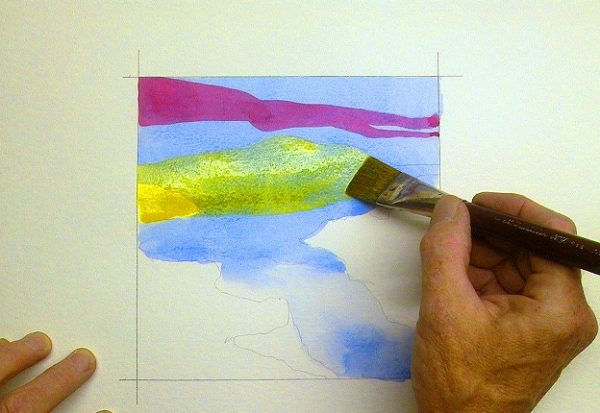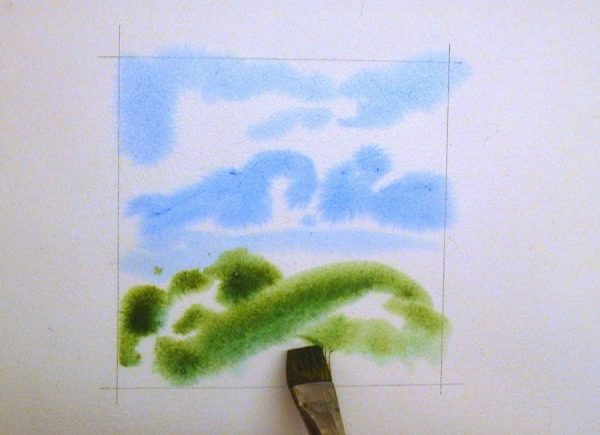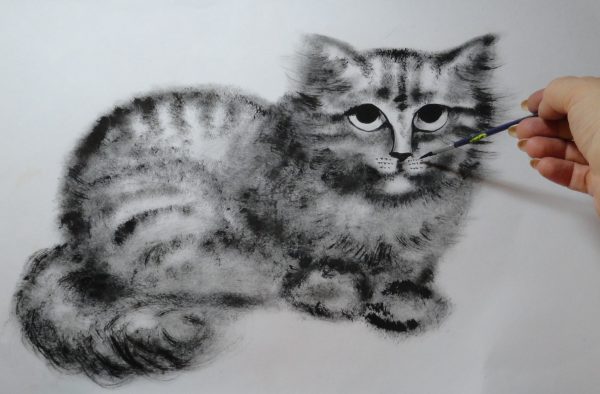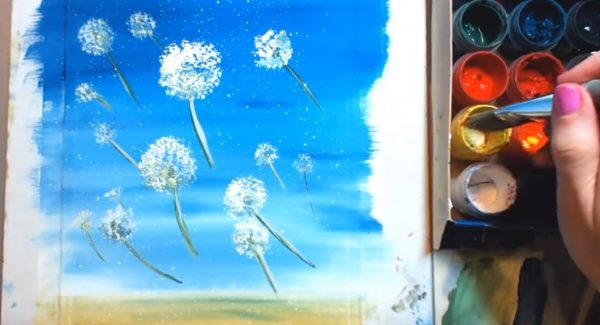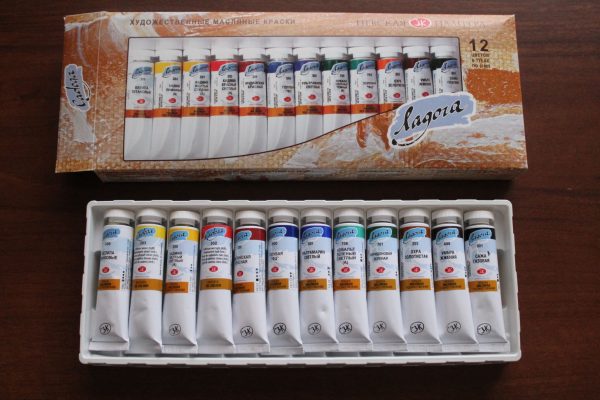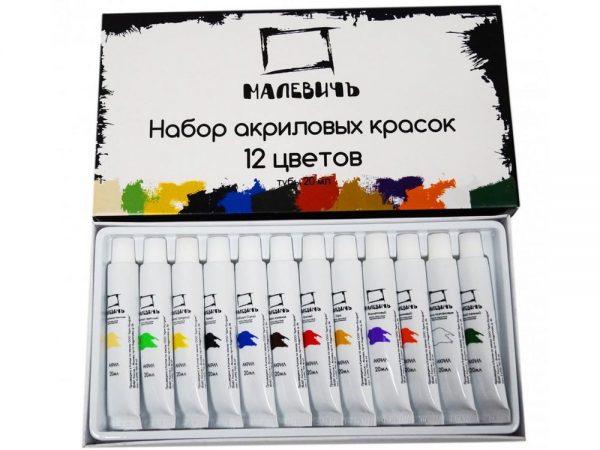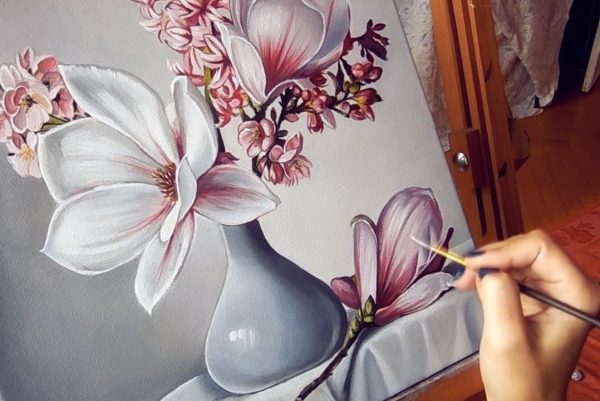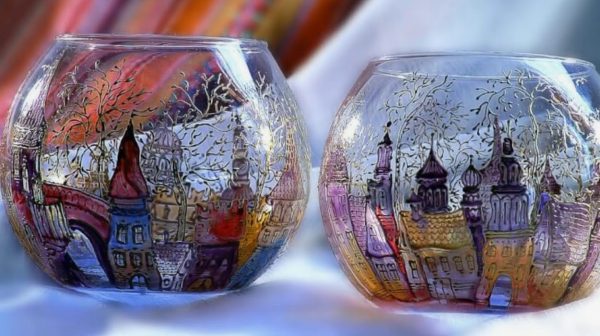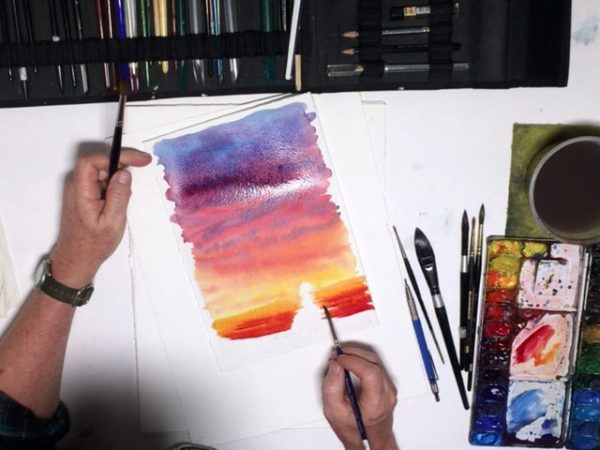Not only children dream of learning to draw, especially since many adults have talents that have remained unfulfilled. There are various lightweight techniques that allow you to start drawing inks for beginners. The easiest way is to learn to work with gouache, you can also use watercolor or oil paints, but you need certain skills to work with the latter.
- Artist set - components
- Watercolor Painting Techniques
- Flat brush
- Gradient
- Watercolor glaze
- Wet Technology
- Dry brush
- Without excess moisture
- Dry paint discoloration
- Gouache for beginners
- Features of oil paints
- Types of oil paints
- Rules and techniques of drawing
- How to draw acrylic: tips for beginners
- Fabric Drawings
- Paintings on canvas
- Drawings on paper
- Glass painting
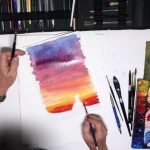
Artist set - components
To learn how to draw, do not do without colors. It’s better to buy high-quality paints right away, because too cheap ones go worse, therefore, the learning process will be less productive. A beginner should not spend money on a professional set: to start drawing from scratch, it is enough to have primary colors:
- titanium white;
- yellow (lemon, medium yellow, ocher yellow);
- red (carmine, cadmium);
- blue;
- emerald and light green;
- the black.
It’s easiest to work with gouache, but an adult or a schoolboy can quite cope with watercolor. The ideal option is not an ordinary nursery, but a watercolor for artists, which has the best quality. Budget sets of 24 colors cost 400-500 rubles. In principle, five tones (red, blue, yellow, white, black) are enough for an artist, and the rest can be created by mixing. To connect the paints you need to immediately buy a palette. Shape, material can be any. On sale there are round, oval, square palettes, wood products, plastic. The size of the palette is also left to the user's choice.
It is equally important to choose a good brush. Beginners need only three brushes, different in size. You can also optionally buy a thin brush for performing bitmaps, small details. Squirrel brushes are most popular - they absorb water perfectly, give it longer, therefore they draw without spots, stripes. Such a brush is good for glazing or creating clear contours.
Suitable for a novice artist and a core brush - round, with a sharp tip. It is also convenient for her to work out subtle contours, elegant details in the watercolor technique. Necessarily in the set there should be a flat wide brush for filling. She perform background or stripes over a large area of the canvas, a sheet of paper. Over time, fan, linear, and retouching are usually added to the collection of brushes. It is important to inspect the brushes for the reliability of the connection between the pile and the handle - it must be very strong.
Other accessories in the artist's kit:
- Paper. For watercolor paints, you should buy special paper with low absorption, which will not allow water to wet the sheet until it dries completely. On plain printer paper, watercolor usually creeps out. The best option is hot-pressed paper, it additionally has a very smooth surface.
- Thinners. Special solvents will be required to dilute oil paints.Typically, linseed oil or turpentine is used for this. Organic solvents are not recommended - they spoil the structure of oil paint, remove a beautiful shine. Nevertheless, to clean the brushes from the paint you need to buy turpentine, white spirit.
- Canvas. Commonly used for oil painting or acrylic paints. There are ready-made canvases in the shops in stretchers of linen, cotton, synthetics. Natural fabrics are dense, sagging little, drawings look more beautiful on them. You can also make a canvas yourself. To do this, you need to buy a stretcher, cover with a cloth, after it primed. As the primer dries, drag the canvas a little tighter.
- Easel. It is recommended to purchase it if you plan to do drawing seriously. The easel is placed at eye level, which gives an excellent overview of the picture, helps to work correctly and quickly look for flaws. There are mini easels for sale on small canvases.
- Protective varnish. It is advisable to cover the picture with varnish, this will help protect it from ultraviolet radiation, make the colors saturated.
to contents ↑Also, to compile a set of the artist you need to buy jars for brushes, wet wipes, cotton rags. To work with oil, you will need a spatula - a spatula for thick paint, removing dried material and applying beautiful strokes. It is also worthwhile to buy grease fittings with clamps (single or double), which contain paint and are easily attached to the palette.
Watercolor Painting Techniques
You need to learn different ways of drawing in stages, moving from the easiest to the most difficult. At first, most artists apply sketching, then they begin to show imagination and create their own masterpieces. It is recommended to start watercolor training with the techniques described below.
Flat brush
If the figure is invented, you should step by step follow these steps:
- Draw a square, a rectangle to indicate the beginning, end of the layer. Dark shade draw a thin line from the upper left corner to the upper right corner.
- Wet the brush with watercolors. The second stroke should be made from the lower edge of the first line, blocking the accumulated paint bottom. It is necessary to work quickly so that water stains do not form or gently wash them with a cloth.
- Repeat this action with the next line. It’s better to use the flat edge of the brush for strokes, which will make the bottom of the stroke more even. Intermittent strokes should be redrawn immediately.
- Completely fill out the intended circuit, repeating the steps in the same way. It is important at the same time to maintain the evenness of the paint tone, not to change the brand of watercolor. On paper that is too thick, strokes may be uneven. Then it is recommended to sprinkle a little leaf with water, get wet, let it dry, and only then proceed to drawing.
to contents ↑At the end of the work, it is necessary to rinse the brush, squeeze it dry, remove all the clots of paint with it at the bottom of the last smear, avoiding discoloration of the picture. To give a textured picture, you can leave it to dry at an angle.
Gradient
First you need to work out a square, a rectangle (in the future it will be a drawing required by the artist). Then the following steps should be taken:
- dip the brush in a dark shade of the required color, draw a vertical or horizontal stroke;
- wipe the brush with a cloth, a paper towel, dip in a lighter shade of the same color, draw a stroke with overlapping part of the previous one;
- rinse, wipe the brush, make another stroke (lighter, darker or a completely different color);
- repeat until the figure is filled;
- rinse brush, dry, pick up paint residue.
Using the gradient, you can create very interesting transitions that form the basis of the future picture.
to contents ↑Watercolor glaze
The glaze technique requires the imagination of the artist, with its help the landscape, the image of autumn and summer, the landscape come out well. Description of the technique on the example of the landscape:
- to fulfill the sky above, the river below using blue watercolor;
- part paint with water, draw a waterfall;
- perform pink clouds in the sky;
- draw the bottom of the picture and the mountain in yellow;
- let all layers dry well;
- with the help of dark blue color to shade the horizon of the mountain and its top, it is also possible to beautifully design a waterfall with it;
- make the riverbank orange, slightly darken the sky;
- as the drawing dries, draw the bubbles on the waterfall in purple;
- you can draw trees along the banks of the river - trunks are brown, leaves are green;
- Shade blue sky, water;
- blue, green to draw grass;
- You can depict trees and fruits beneath them.
The meaning of glazing is that all layers of paint interact with each other, overlap one another and, when overlapped, give even more interesting effects.
to contents ↑Wet Technology
Before drawing, moisten a sheet of paper with water. Of course, paper is needed thick, not deoxidizing. Wetting is carried out using a sponge, having previously squeezed it. Moisture should be evenly distributed on the sheet and not shine, otherwise there is too much water on it.
Further, on paper, you can perform any pattern, for example, an autumn bouquet:
- First, draw a background, choosing any light shade;
- make a vase drawing;
- draw leaves in a vase using yellow, red, orange;
- apply every new shade after partial drying of the previous one, the blurry lines create very interesting effects;
- at the end of the work, you can place accents with the help of brown, dark brown, burgundy, perform shadows;
- with a wet clean brush, do some blurring of the borders, but do not overdo it to exclude a sloppy appearance of the picture.
It is not necessary to combine cold and warm tones in one picture, this will give visual dissonance.
to contents ↑Dry brush
In this technique, drawing is easy. Paint should be taken on a dry brush, then smear on paper. It is preliminary recommended to sketch with a pencil. At first, the sketches will be rather rough - for example, the outlines of the sky, tree trunks and branches, a river. After the first layer has dried, add details, create shadows, draw a texture. Then they make a background around, place the necessary accents.
When drawing, you need to change the pressure on the brush, which will add or remove texture. It is important that the brush after washing and blotting does not remain too wet. Otherwise, the paint will not give the effect of texture, it will look flat.
to contents ↑Without excess moisture
The technique is well suited for drawing clouds, streams of light. Before starting work, you need to prepare a few sponges or sponges for the face. First, smears are performed with a dry or wet brush, then they are rubbed with sponges. It is important not to rub the sheet hard so as not to damage the paper. Lightening can be done with paper towels. Then, if necessary, contours of drawings and accents are made with a thin dry brush.
to contents ↑Dry paint discoloration
In this case, the already dried pattern is clarified. The necessary areas need to be moistened with a cloth, gently wipe with a dry brush. It is best to use brushes with hard bristles that can scrape off the paint a little. Actions must be neat, otherwise there is a risk of damage to the paper. Instead of using rags, it is permissible to sprinkle paper from the spray bottle, and then moisten the moisture with a paper towel. Another option is to gently rub the pattern with sandpaper, then you do not need to wet it first.
to contents ↑Gouache for beginners
Usually, learning to draw with gouache is recommended even in childhood - from 4-6 years. It is very easy to apply, does not float, and is much easier to work with than watercolor. Gouache drawings can be very diverse - nature, animals, flowers and trees, fruits, etc. Adults paint real landscapes with gouache.
You can perform drawings not only on paper, but also on canvas, plywood, wood, fabric, even on stones, pebbles. For this purpose, it is better to purchase not children's, but artistic gouache, which is of high quality.First, a pencil sketch is performed, after which it is painted over. Start with dark colors, gradually moving to light. It is necessary to mix paints taking into account the color wheel, otherwise the result will be a gray tone.
to contents ↑Features of oil paints
Artists with experience really appreciate oil paints, which are in a wide range in specialized stores. The composition of paints contains minerals, organic and synthetic components. They are not diluted with water, but with linseed oil, which gives brightness, saturation. The paints dry for a long time, but the pattern can be corrected for a certain time. For the cultivation of dried, thickened paint, special oil is also used, which is sold in the art departments.
to contents ↑Types of oil paints
There are three types of oil paints:
- Highly artistic. Usually they are used for professional painting. The price of the material is high due to the excellent quality of the components. For decades, paints do not lose color, do not fade.
- Sketchy. Suitable for beginners, are inexpensive, can be used in different techniques.
- Studio. They have an intermediate price between the two listed options, suitable for artists and beginners.
to contents ↑Also, oil paints are transparent, opaque. The second is more dense, do not let in light. If the packaging is marked with a “*”, such material is very durable, lasts a long time. The more stars, the higher the quality of the paint.
Rules and techniques of drawing
The oil painting looks very beautiful. Smears look each on their own, although it is rather difficult to achieve such an effect. There are two main techniques: in one coating (alla prima) and in several layers. For multi-layer application of paints you will have to try - work quickly, do not dilute the material, know its properties and how one tone will look on top of the second. Oil consumption for multilayer application is usually large.
A single-layer drawing has its drawbacks. So, over time, smears can crack due to the squeezing of the paint, so most professionals dry the first coat and apply at least one more. So material costs can be reduced.
Recommendations when working with oil:
- the lighting should be good, otherwise there is a risk of making unnecessary shadows in the picture;
- first you need to draw a contour, then along the lines carry out oil strokes;
- colors can be mixed, knowing the basic principles of the combination of tones;
- usually paint, starting with bright elements, highlighting the darkest and lightest points;
- after the sketch is completed, contours and details are drawn, the necessary accents are made;
- the finished picture must be allowed to dry for three days, but on the second day you can make some changes;
- After drying, the sheet must not be rubbed or touched by hands.
How to draw acrylic: tips for beginners
Acrylic paints combine the properties of oil and watercolors, they do not fade, they are not afraid of water. You can apply layers directly to the previous ones, without waiting for them to dry. To begin with, it is better to buy a set of 6 colors, then expand to 18. To draw with acrylic is on paper, canvas, fabric, glass, plastic, stones. Dilute the paint with water, solvents. The following techniques are used:
- dry - on paper, canvas;
- wet - on wetted canvas;
- glazing - applying a thick layer and its subsequent shading;
- impasto - drawing with clearly visible strokes.
To give the drawing a finished look, you can apply individual strokes with felt-tip pens, markers, pencils, pastels. First, simple pictures are made, then they go on to still lifes, window views, portraits. For training, it will be useful to apply the technique of abstraction - make spots and add details, giving them an image.
Acrylic tips are:
- nearby you need to have a spray with water to wet quick-drying paints;
- when water is added, a more transparent material can be made from acrylic paint;
- it is impossible to enter too much water, after drying, the paint may crumble;
- before wetting the brush in the paint, you need to dry it;
- the addition of solvent, not water, will help to slow the drying of the material;
- to preserve the pattern, it is varnished.
Fabric Drawings
It is rather difficult to make fabric drawings, it is better to train on a different basis. If you have experience, it is quite possible to draw on silk, synthetics, natural fabrics. First, the fabric needs to be washed, ironed, pulled onto a frame or placed on a flat base. Put an oilcloth under the fabric, make a drawing with a special felt-tip pen for matter. After completing art painting. It’s easiest to work on ready-made stencils, but you can make a drawing yourself. After a day of drying, you need to iron the product with an iron, after 2 days it can be washed.
to contents ↑Paintings on canvas
Canvas is an ideal base for acrylic. Paints must be prepared in advance, diluted with water. If mixing is planned, it is better to use a special solvent, otherwise the material will dry quickly. The palette should be periodically sprayed with water. They begin to draw the largest details, as they draw smaller lines, they change their brushes to thin ones. The rate of dilution of paints with water to create more transparent tones is less than 20%.
Drawings on paper
For the first time, you should try drawing on paper. Since the structure of the inks is dense (it is, in fact, liquid plastic), ordinary thin paper will not work. It is better to take cardboard or special thick paper. Also, drawings can be done on paper wallpapers that are already glued to the walls. This is a popular design technique that allows you to decorate plain material and give the room an original look.
Glass painting
Pictures on glass look very beautiful, reminiscent of a finished stained glass window. The contours of the future drawing make a thin marker on the sketch, which is placed under the glass. After paint is applied layer by layer, forming the necessary combination of colors, accents, lighter and darker areas. At the end of the work, acrylic varnish is applied to the painting.
Paints give endless scope for imagination. Learning to draw is easy. Even without talent, you can perform beautiful drawings with sufficient diligence and perseverance.

